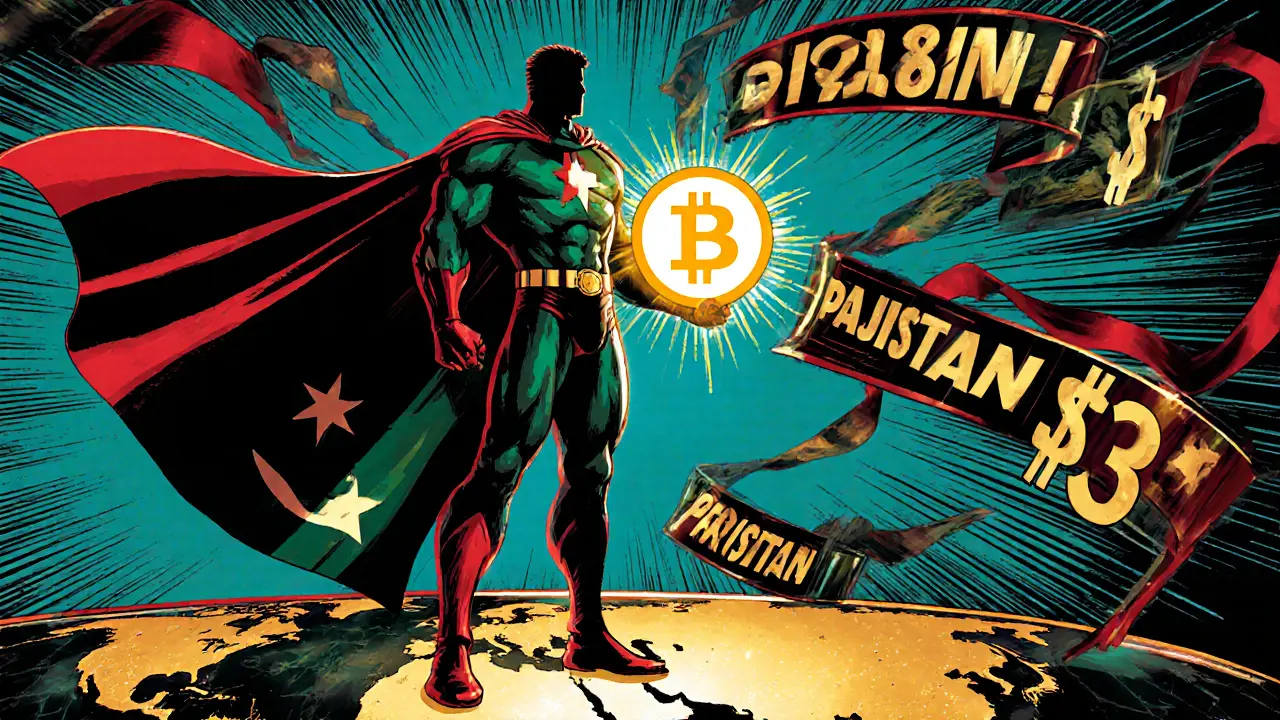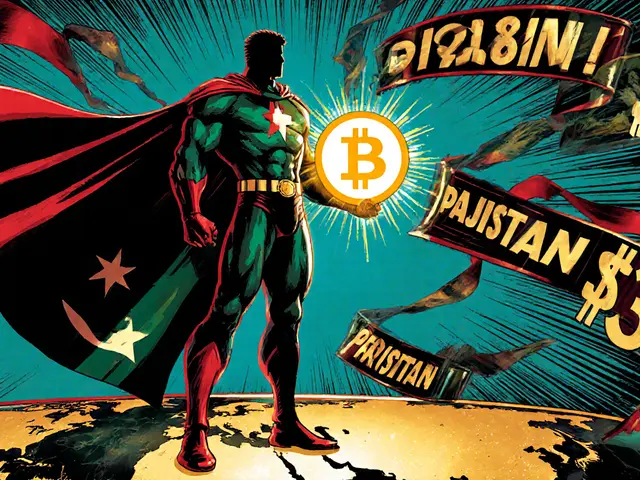Pakistan Crypto Adoption Calculator
User Inputs
Results
Enter values and click "Calculate Impact" to see detailed analysis.
When the latest Chainalysis Global Adoption Index landed in October 2025, it placed Pakistan as the third‑largest crypto‑adopting nation on the planet, right behind India and the United States. That jump of six spots in a single year stunned analysts and raised a flood of questions: How did the country move so fast? Which metrics are really behind the ranking? And what does this mean for investors, regulators, and everyday users?
Key Takeaways
- Chainalysis ranks Pakistan 3rd globally in 2025, while other indexes place it between 4th and 9th.
- ~20million Pakistanis hold $20‑25billion in digital assets, far above the global average ownership rate.
- Regulatory overhaul - the creation of the Pakistan Virtual Assets Regulatory Authority (PVARA) and the Pakistan Crypto Council - is the biggest catalyst.
- Stablecoins used for remittances and inflation hedging drive most of the volume, not speculative trading.
- Geopolitical ties with the United States and private‑sector partners add both opportunities and volatility risks.
Understanding the Rankings: Methodology Matters
Not every "top‑10" list is created equal. Chainalysis builds its index from four sub‑indexes: retail volume, institutional volume, on‑chain activity, and purchasing‑power‑adjusted metrics. By weighting transaction value against PPP, the model rewards countries where crypto moves a lot of money relative to local buying power - a sweet spot for Pakistan’s economy.
Another popular study released in May 2025 used a different formula, focusing on ownership rates per capita and a simple count of wallet addresses. That approach slotted Pakistan at 9th worldwide, behind Nigeria, Indonesia, and Vietnam. The discrepancy highlights two things:
- Volume‑based metrics (Chainalysis) showcase real‑world utility - people are actually using crypto to pay, save, or send money.
- Ownership‑based metrics capture potential but can over‑state impact in countries where wallets sit idle.
Numbers Behind the Surge
According to the data compiled by Chainalysis, Pakistan’s crypto ecosystem generated roughly $4.5billion in on‑chain transaction volume in the 12‑month period July2024-June2025. That figure represents about 18% of the country’s total foreign‑exchange inflows, a remarkable share for a market that once banned crypto outright.
Population‑adjusted estimates put the crypto‑holding rate at roughly 8‑9% - double the global average of 6.9% reported for 2024. With ~20million users holding a combined $20‑25billion, the average Pakistani crypto wallet is worth about $1,200, a figure that rivals many European nations.
Regulatory Turnaround: From Ban to Blueprint
Back in 2018 the State Bank of Pakistan declared digital currencies illegal tender and ordered exchange firms to shut down. Fast forward to July 2025, and the same government launched the Pakistan Virtual Assets Regulatory Authority, giving the industry a clear legal framework, licensing regime, and AML/KYC standards.
The Pakistan Crypto Council, led by CEO Bin Saqib, acts as the industry‑government bridge. Its charter includes:
- Drafting taxation guidelines for crypto gains.
- Facilitating cross‑border stablecoin pipelines for remittances.
- Coordinating with the central bank on stablecoin reserve requirements.
Finance Minister Muhammad Aurangzeb publicly endorsed the council in June 2025, emphasizing that “digital assets can bolster financial inclusion while protecting our macro‑economic stability.”

Why Stablecoins and Remittances Lead the Charge
Pakistan receives roughly $30billion in remittances each year, primarily from the diaspora in the Gulf, Europe, and North America. Traditional money‑transfer services charge 5‑8% per transaction, ate away by inflation, and often require physical cash pickup.
Enter stablecoins: US‑dollar‑pegged tokens like USDC and Tether allow workers to send money at 0.5‑1% fees, settle instantly on‑chain, and be stored in a digital wallet that can be converted to local fiat at regulated exchanges. The speed and cost advantage has turned stablecoins into the de‑facto vehicle for cross‑border transfers.
At the same time, hyperinflation (average 13% YoY in 2024) pushes households to seek stores of value outside the Pakistani rupee. Crypto, especially Bitcoin, offers a hedge. Yet the majority of volume remains in stablecoins because they serve everyday transactional needs without price volatility.
Comparative Landscape: Pakistan vs. Other Leaders
| Country | Chainalysis Volume‑Adjusted Rank | Ownership‑Rate Rank |
|---|---|---|
| India | 1 | 1 |
| United States | 2 | 4 |
| Pakistan | 3 | 9 |
| Vietnam | 5 | 5 |
| Nigeria | 6 | 2 |
Notice how Pakistan leaps ahead in the volume‑adjusted view but lags in pure ownership counts. That gap tells a story: the country’s users are highly active, moving money frequently, even if the total number of wallets is lower than in Nigeria or Indonesia.
Future Outlook: Staying in the Top‑10
Analysts project that global crypto users will reach 600million by the end of 2025 and cross 1billion by 2030. If Pakistan keeps its current growth rate of ~38% YoY in transaction volume, it could hold 12‑15% of the global new‑user inflow, cementing a top‑five spot for years to come.
Key variables that will determine whether the momentum sustains:
- Regulatory consistency: PVARA must avoid frequent policy flips that could scare institutional investors.
- Banking integration: Partnerships with local banks to offer on‑ramp/off‑ramp services will broaden the user base beyond tech‑savvy millennials.
- Geopolitical balance: The August 2025 agreement with World Liberty Financial (linked to the Trump family) brings capital but also scrutiny from Western regulators concerning AML compliance.
- Education and consumer protection: Programs that teach safe wallet handling and tax reporting will reduce fraud‑related backlash.
If these pillars hold, Pakistan could not only keep its spot but also serve as a model for other emerging markets looking to turn crypto into a practical financial tool.
Risks and Controversies
While the headline numbers are impressive, there are real concerns:
- Speculative spillover: A sudden influx of crypto‑focused venture capital could inflate asset prices, creating a bubble that bursts if global sentiment turns negative.
- External dependencies: Partnerships with U.S. firms like MicroStrategy (led by Michael Saylor) bring expertise but also tie Pakistan’s crypto policy to foreign corporate interests.
- Regulatory arbitrage: Neighboring countries may view Pakistan’s lenient stance as a haven for illicit flows, prompting stricter cross‑border AML measures that could choke legitimate remittance pipelines.
Policymakers acknowledge these risks and are drafting contingency frameworks, but the path forward will require careful balancing.
Takeaway for Investors and Users
If you’re a crypto investor, Pakistan’s ranking signals a growing market for on‑ramp services, stablecoin liquidity pools, and localized DeFi projects. For everyday users, the rise of regulated exchanges and affordable stablecoin remittance routes means cheaper, faster money transfers for families abroad.
Watch for upcoming PVARA licensing rounds - they’ll likely unlock the next wave of institutional participation, from custodial banks to tokenized asset platforms.

Frequently Asked Questions
Why does Pakistan rank higher in volume‑adjusted indexes than in ownership‑rate lists?
Volume‑adjusted indexes, like Chainalysis’s, weigh the amount of crypto moved against local purchasing power. Pakistan’s users send large remittance‑linked stablecoin transfers, which boosts the volume metric even though the total number of wallets is smaller than in Nigeria or Indonesia.
What role does the Pakistan Crypto Council play?
The Council acts as a liaison between the government, regulators, and the private sector. It drafts tax guidelines, oversees stablecoin integration for remittances, and coordinates with the Pakistan Virtual Assets Regulatory Authority to issue licenses.
Are stablecoins safe for everyday transactions in Pakistan?
Stability comes from the peg to the US dollar, not from the underlying blockchain. Regulated exchanges now offer insured custodial wallets, and PVARA requires issuers to hold reserves. While no system is risk‑free, stablecoins are currently the cheapest way to send money across borders.
How might geopolitics affect Pakistan’s crypto future?
Partnerships with U.S. firms bring capital and expertise but also invite scrutiny from Western AML regulators. A shift in U.S. policy could force Pakistan to tighten its own rules, potentially slowing growth. Conversely, strong diplomatic ties could unlock more cross‑border financing.
What should an investor look for when entering the Pakistani crypto market?
Check if the platform holds a PVARA license, verify its AML/KYC compliance, and assess its stablecoin liquidity pools. Also, monitor policy updates from the Pakistan Crypto Council, as they often signal upcoming regulatory changes.



vincent gaytano
October 29 2024Imagine a world where every financial reform is a covert rehearsal for a grander scheme, and the spotlight shines on Pakistan’s crypto boom. The narrative of progress masks a deeper agenda to funnel capital through channels beyond traditional oversight. Stablecoins, while lauded for cheap remittances, become the perfect conduit for shadowy actors to sidestep scrutiny. One cannot ignore the timing of the regulatory overhaul, coinciding with a surge of foreign fintech interests eager for a foothold. It feels less like organic adoption and more like a staged performance orchestrated by unseen hands.
Dyeshanae Navarro
October 31 2024From a philosophical standpoint, the rise of crypto in Pakistan reflects humanity's perennial quest for autonomy over one's resources. When people can move money without gatekeepers, they reclaim a measure of dignity that aligns with basic ethical principles. The stablecoin mechanism, in particular, offers a pragmatic bridge between technology and everyday necessity, embodying the ideal of tools serving human well‑being.
Matt Potter
November 3 2024We should celebrate this momentum and push the ecosystem even further-more licensing, deeper integration with banks, and wider education campaigns will turn Pakistan into a true crypto powerhouse. The optimism is justified; the numbers speak for themselves, and the future looks bright.
Marli Ramos
November 5 2024lol stablecoins are just fancy internet money 😂
Christina Lombardi-Somaschini
November 7 2024The recent surge in Pakistan's crypto activity warrants a nuanced examination of both macroeconomic incentives and regulatory developments. First, the pervasive reliance on remittances creates a natural demand for low‑cost, borderless transfer mechanisms, which stablecoins efficiently satisfy. Second, the establishment of PVARA provides a legal scaffolding that mitigates previous uncertainties, thereby encouraging institutional participation. Third, the inflationary pressures experienced domestically amplify the appeal of assets that can preserve purchasing power relative to the rupee. Moreover, the data cited by Chainalysis underscores a volume‑adjusted ranking that reflects actual transaction flow rather than mere wallet counts. This methodological distinction explains why Pakistan appears higher in volume‑adjusted lists while lagging in pure ownership metrics. In addition, the collaboration between the Pakistan Crypto Council and licensed exchanges facilitates on‑ramps that are both compliant and user‑friendly. The council’s role in drafting tax guidelines further integrates crypto activities within the broader fiscal framework. It is also noteworthy that stablecoin liquidity pools have been bolstered by partnerships with regional fintech firms, enhancing accessibility for the average user. From a geopolitical perspective, the engagement with U.S. financial entities introduces capital inflows but simultaneously subjects the ecosystem to heightened AML scrutiny. Consequently, policymakers must balance openness with robust compliance measures to avoid potential sanctions. Looking ahead, if the current growth trajectory of approximately thirty‑eight percent annual volume persists, Pakistan could command a double‑digit share of global new‑user inflows. Such a scenario would not only solidify its standing among the top five adopters but also position the nation as a case study for emerging markets. However, this optimistic outlook hinges on three critical pillars: regulatory consistency, banking integration, and sustained education initiatives. Any deviation-particularly abrupt policy reversals-could erode user confidence and stall momentum. In sum, the convergence of remittance economics, regulatory reform, and stablecoin utility forms the cornerstone of Pakistan's rapid ascent in the crypto domain.
katie sears
November 10 2024Building upon the detailed analysis, it is essential to recognize the cultural dimension of crypto uptake. Community outreach programs that respect local customs can accelerate adoption while safeguarding against misuse. The council’s inclusive policies, when coupled with transparent licensing, will foster trust across diverse demographics.
Gaurav Joshi
November 12 2024The moral imperative is clear: without ethical oversight, rapid growth can become a double‑edged sword; we must demand accountability from every stakeholder involved.
Kathryn Moore
November 14 2024Crypto growth equals risk, use licensed exchangers.
Christine Wray
November 17 2024I appreciate the balanced view presented; the data-driven perspective helps cut through the hype and reveals the genuine benefits that stablecoins bring to everyday users.
roshan nair
November 19 2024From a technical standpoint, the integration of stablecoin bridges with local fiat gateways reduces friction dramatically. When a worker in Karachi sends $500 via USDC, the transaction settles in seconds, bypassing the 5‑8% fees of traditional hawala networks. This efficiency not only saves families money but also creates a transparent audit trail that regulators can monitor without stifling user freedom. Moreover, the colorfully diverse DeFi projects emerging in Pakistan are leveraging these bridges to offer micro‑loans and yield farming opportunities that were previously inaccessible.
Jay K
November 21 2024The technical insights you provided are indeed valuable; moreover, the emphasis on formal compliance aligns with the broader goal of integrating crypto into the national financial architecture.
Kimberly M
November 24 2024Great summary! 👍 The stablecoin routes really do make sending money home feel like a breeze.
Navneet kaur
November 26 2024While emojis are fun, it’s crucial to remember that under‑regulation can expose users to scams; the community should push for stricter standards, not just celebrate convenience.
Marketta Hawkins
November 28 2024Patriots must demand that our government safeguards this goldmine of economic independence; allowing foreign entities unchecked access is a betrayal of national interests.
Drizzy Drake
December 1 2024It’s truly heartening to see how the convergence of technology and necessity is reshaping lives across Pakistan. When families can receive money instantly and affordably, the ripple effects touch education, health, and overall well‑being. I’ve spoken with several expatriates who now prefer stablecoins over legacy money‑transfer services because the savings are tangible. Their stories highlight how reduced fees translate into better schooling for children and more nutritious meals. Moreover, the regulatory clarity provided by PVARA is building confidence among local businesses that want to accept crypto payments. This, in turn, fuels a virtuous cycle where merchants adopt digital wallets, driving further adoption. The educational initiatives being rolled out by the Crypto Council are also pivotal; they demystify blockchain concepts for the average citizen, reducing fear and misinformation. As more people understand the mechanics, the ecosystem becomes more resilient to scams. It’s also worth noting that some forward‑thinking banks are experimenting with custodial services, bridging the gap between fiat and crypto. Such collaborations could unlock new credit products backed by digital assets, expanding financial inclusion. Overall, the momentum we’re witnessing isn’t a fleeting trend but a foundational shift toward a more decentralized, accessible economic future.
AJAY KUMAR
December 3 2024The fervor surrounding crypto must be channeled with national pride; we cannot let foreign influence dictate our monetary destiny, lest we lose sovereignty forever.
bob newman
December 5 2024Sure, the numbers look impressive, but ask yourself who really benefits when the “crypto revolution” is driven by the same elites who have been pulling strings behind every financial crisis.
Anil Paudyal
December 7 2024Overall, it’s a solid development, but staying vigilant will be key.